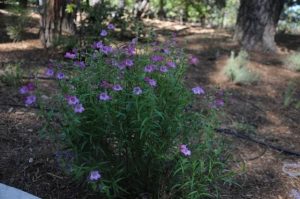It’s amazing how time flies! It seems just like yesterday that I moved from my beloved country property in Tuolumne County to Oakley in the Sacramento/San Joaquin Delta. There I started the process of planting a new native backyard garden. Now, fourteen months later, the bare earth has come alive with a wide variety of plants, shade trees, bubbling fountains and garden art galore. In this final article about my transition, I would like to share principles than can be applied to developing a native garden no matter where you live.
Focus on native plants: To surround the back patio (where my Japanese Maples once resided) I planted native Toyon (Heteromeles arbutifolia) and Pacific Wax Myrtle (Myrica californica), shrubs which will eventually grow tall enough to make a cozy sheltered retreat. Other native plants added throughout the yard include several sages (Salvia ssp.), Penstemon, California Fuchsia (Zauschneria californica), Ceanothus “Frosty Blue’ and a Matilija Poppy (Romneya coulteri)….my fifth attempt to grow this native!
Add non-natives for specific purposes: With the exception of a native Incense Cedar (Calocedrus decurrens), the trees planted this fall were chosen to be fast growers to create shade and privacy. I chose fruitless Mulberry (Morus alba), Flowering Plum (Prunus cerasifera ‘Krauter Vesuvius’), Western Red Cedar (Thuja plicata ‘Green Giant’), Tulip Tree (Liriodendron tulipifera) and Crape Myrtle (Lagerstroemia hybrid ‘Natchez’). To provide privacy on either side of the yard, I chose two species of non-invasive, clumping bamboos (Bambusa multiplex ‘Alphonse Karr’ and Bambusa ventricosa ‘Buddha’s Belly’) and Podocarpus.
Create meadows that duplicate the native environment: As planting progressed throughout the year, excess soil from planting holes was piled in two areas of the garden. One of these ‘mounds’ became home to a bush poppy (Dendomecon rigida) and I added daffodil bulbs for spring color. The other larger mound was raked out to make a very small meadow, which-just this past week-has become a native Purple Needlegrass (Nasella pulcra) and native wildflower spot.
Find a good helper: While stressful at times, I have enjoyed the process of designing and planting a new yard. I have been fortunate enough to find a gardener who is willing to implement my sometimes ‘half-baked’ plans without walking off the job.
Practice patience: I also learned that patience really is important when gardening. Had I been a bit more patient, I would have waited to go through a full year of seasons in my new city. If I had, I would have made better decisions as to what to do first-like planting trees and installing irrigation lines.
Plant all the natives in the fall. As I reported earlier, I got a late start planting natives and lost many plants due to unseasonably warm temperatures and drying winds. Thankfully, I am happy to report that the natives planted last February and March have really started growing and are looking spectacular. And once again, I’m pushing the envelope-I know it may be a little late to sow wildflower seeds. However, I really want to see what will bloom this year, so I will still scatter wildflower seeds. I plan to add a more diverse selection of wildflowers next fall.
With this article I say farewell to the loyal readers of this column. It has been my pleasure to be among the UCCE Master Gardener writers, who each week for the past many years have shared gardening information with foothill gardeners. This is the last article I will be writing, as my tenure with the Tuolumne Master Gardeners has come to a close. I have enjoyed writing and sharing my gardening successes and failures and hope that some of those experiences have helped many of you in your gardening endeavors. May you all be blessed with birds, bees, butterflies and blooms in your garden all year long.
Carolee James hopes to join the Contra Costa County, CA, Master Gardeners as well as a local gardening club in 2013.




